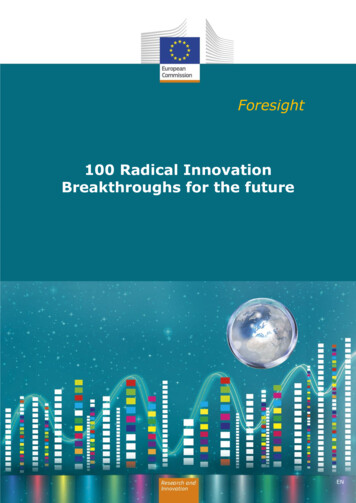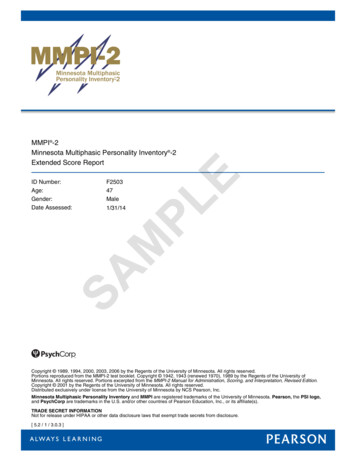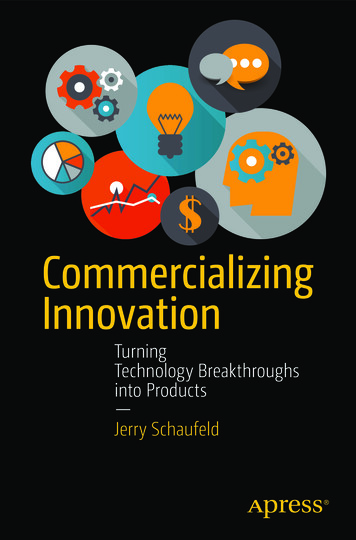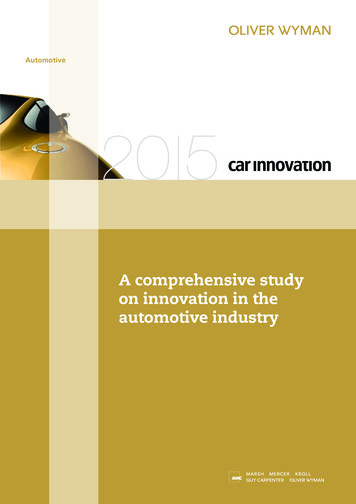
Transcription
Foresight100 Radical InnovationBreakthroughs for the futureEN
100 Radical Innovation Breakthroughs for the futureEuropean CommissionDirectorate-General for Research and InnovationDirectorate A — Policy Development and CoordinationUnit A.2 — Research & Innovation StrategyContact Nikolaos PUBLICATIONS@ec.europa.euEuropean CommissionB-1049 BrusselsManuscript completed in May 2019 – re-edition November 2019This document has been prepared for the European Commission however it reflects the views only of the authors, andthe Commission cannot be held responsible for any use which may be made of the information contained therein.More information on the European Union is available on the internet (http://europa.eu).Neither the European Commission nor any person acting on behalf of the Commission is responsible for the use, whichmight be made of the following information.The views expressed in this publication are the sole responsibility of the authors and do not necessarily reflect the viewsof the European Commission.Luxembourg: Publications Office of the European Union, 2019PDFISBN 978-92-76-13045-1doi: 10.2777/563770KI-01-19-886-EN-N European Union, 2019.Reuse is authorised provided the source is acknowledged. The reuse policy of European Commission documents isregulated by Decision 2011/833/EU (OJ L 330, 14.12.2011, p. 39).For any use or reproduction of photos or other material that is not under the EU copyright, permission must be soughtdirectly from the copyright holders.Cover page image: Lonely # 46246900, ag visuell #16440826, Sean Gladwell #6018533, LwRedStorm #3348265,2011; kras99 #43746830, 2012. Source: Fotolia.com.
EUROPEAN COMMISSION100 Radical InnovationBreakthroughs for the futureThe Radical Innovation Breakthrough InquirerAuthorsPhiline Warnke, Kerstin Cuhls, Ulrich Schmoch, Lea DanielFraunhofer ISILiviu Andreescu, Bianca Dragomir, Radu Gheorghiu, Catalina Baboschi, Adrian CurajInstitutul de ProspectivăMarjukka Parkkinen, Osmo KuusiUniversity of Turku2019Directorate-General for Research and InnovationEN
AcknowledgementsOur special thanks go to the foresight team of DG RTD, Nikolaos Kastrinosand Nathalie Vercruysse. They organized the workshops in Brussels,contributed to reports and workshop agendas, and supported the project witha lot of patience until the very end.The following collaborators have greatly contributed to the drafting oftechnological briefs that are presented in this report: Enache Vlad, UngureanuIrina, Burinaru Tiberiu, Ilian Virgil, Vieru Vlad, Brabete Valentin, CojocaruOvidiu, Chihaia Viorel, Chiriac Alexandru, Tudorie George, Mitarca Monica,Popa Octavian, Ungureanu Viorel, Cosmescu Codruta, Matei Lilia, Sima Maria.We express our sincere appreciation to the distinguished panel ofinterviewees who shared their expertise and time to discuss Global ValueNetworks in fall 2017: André Alvarim, Anzori Barkalaja, Martin Bristol,Jennifer Cassingena Harper, Zoya Damianova, Tea Danilov, Martin Fatun,Patrick Garda, Anne Guichard, Eric Hauet, Jozef Herčko, Lars Klüver, SofiKurki, Ira Van Keulen, Emmanuel Koukios, Alois Krtil, Jan Lesinsky, TõnisMets, Katrien Mondt, László Monostori, Michael Nentwich, Juan Carlos Parajó,Melanie Peters, Roberto Poli, Robert Redhammer, Ramojus Reimeris, MariRell, Anna Sacio-Szymańska, Róbert Šimončič, Peter De Smedt, PeterStanovnik, Amos Taylor, Arnold Ubelis, Anders Vestergaard Jensen and KarlWestberg. In addition, we express our gratitude to Jurgita Petrauskienė andEugenijus Butkus for a discussion on the topic.A special “thank you” is given to the PhD Panel that filled in the survey onGlobal Value Networks and Radical Innovation Breakthroughs in spring 2018under severe time pressure: Ernest Aigner, Divya Balakrishnan, RobertEmprechtinger, Laura Hille, Jan Janošec, Anton Jansson, Nikolaos Korakas,Ilya Kuzovkin, Daniel Alsina Leal, Ashish Rauniyar, Adrian Sima, JaroslawSkowronski, Amos Taylor, Fabiana Troisi, Irina Ungureanu, Marjolein van derWaal.We are very thankful for the active contributions of the participants in ourworkshops in Brussels. The speakers of our workshop on Global ValueNetworks were Barbara Haering, E-Concept AG, Ezio Andreta, ConsiglioNazionale delle Ricerche, Adrian Curaj, Institul de Prospectiva, MichaelKeenan, OECD, Osmo Kuusi, Finland Futures, Andrea Renda, Center forEuropean Policy Studies, Keith Smith, Imperial College London, and theMember of the Committee of the Future of the Parliament of Finland VilleVähämäki. Active groupwork participants were: Michele Acciaro, KühneLogistics University, Amanda Allertop Sorensen, Copenhagen EU Office,Antonio Alvarenga, ALVA RC, Carlos Alvarez-Pereira, Innaxis Foundation &Research Institute, Maria Boile, Hellenic Institute for transport, MichaelCarus, Nova-Institute for Ecology & Innovation, Tea Danilov, ForesightCenter, Dianne Dredge, Aalborg University, Charles Featherstone,Government Office for Science, Siliva Ganzerla, EUROCITIES, KenishaGarnett, Cranfield University, Christian Grunwald, Z-Punkt ForesightCompany, Olli Hietanen, University of Turku, Pierfrancesco Moretti, ConsiglioNazionale delle Ricerche, Augusta Maria Paci, Consiglio Nazionale delleRicerche,Aape Pohjavirta, Funzi, Ramojus Reimeris, Research & HigherEducation Monitoring and Analysis, Sybille Vandenhove, Bridging forSustainability SPRL, Barend Van der Meulen, Rathenau Institute, BosjanVasle, Governmental Institute of Macroeconomics Analysis, Catherine2
Whitelegg, German Federal Ministry for Education and Research, AlfredWuëst, EAWAG, Swiss Federal Institute of Aquatic S & T as our externalguests; and from EU institutions Thomas Arnold, DG RTD, Olivier Chassagne,DG GROW, Nuno Eca Guimaraes, DG JUST, Elisabeta Florescu, JRC, ArturFurtado, DG SANTE, Laszlo Helmle, DG RTD, Ilona Lelonek Husting, DGGROW, Cristina Marolda, DG MOVE, Elena Montani, DG ENV, Eamonn Noonan,Europan Parliament Research Service, Daniele Rechard, Europan ParliamentResearch Service, David Rios Morentin, DG HOME, Frank Smit, DG RTD,Vincent Viaud, European, Environment Agency.During the final RIBRI workshop, we discussed vividly with Thomas Arnold(RTD), Laure Baillargeon (GROW), Florence Buchholze (AGRI), OlivierChassagne (GROW), Fabrizio Colimberti (RTD), Phebe Dudek (RTD), ElizabethFlorescu (JRC), Jessica Giraldi (JRC), Georgios Kastrinos (RTD), KaterinaKokesova (RTD), Raphaela Kotsch (RTD), Carla Santos, Harald Stieber(JUST), Eckhard Stormer (JRC), Szekacs Szabolcs (GROW), Luigi Vitiello(GROW) and Jyri Ylkanen (GROW). Thank you for the additional input!3
FOREWORDHorizon 2020 and Horizon Europe are ambitious EUresearch and innovation programmes aiming atstrengthening science, technology and innovation,fostering European industrial competiveness, andhelping to achieve the Sustainable DevelopmentGoals. These ambitions will require a step-change inbreakthrough innovation in Europe. The proposalfor the European Innovation Council is at the heartof our ambitions for breakthrough innovations. Butit is not alone. Breakthrough innovations are needed to boost the quality ofour science as well as to address the many challenges faced by people today,individually as well as collectively.Our Horizon Scanning for Radical Innovation Breakthroughs is part of thepreparation for Horizon Europe’s implementation. A massive automatedsurvey of recent scientific and technical literature filtered through panels ofexperts has been combined with reviews of important recent foresightprojects worldwide. The results have been screened for their potential impacton future global value creation, and assessed in terms of current maturity,long-term diffusion potential and relative strength of the EU in research andinnovation.This report “100 radical innovation breakthroughs for the future” captures themost potentially impactful results. It provides a strategic resource to all thoseconcerned with decisions on science, technology and innovation. Forexample, in EU research and innovation policy planning we need tounderstand the potential of breakthroughs as enablers or barriers tosustainability transitions. Such transitions involve interactions and potentialsynergies between different policies of the Union. The collection of radicalinnovation breakthroughs can create common references between differentpolicies and facilitate interactions.With the publication of this report, we hope to also contribute to national andregional strategies, be they on research and innovation priorities or on smartspecialization. To improve the lives of people, our reflection about the futureshould be inspired by the goals of sustainability in order to stretch theboundaries of what is feasible in function of what is desirable forpeople. Radical innovation breakthroughs are aspirational and inspirational.Scanning the horizon to identify them is a growing part of policy intelligence.Jean-Eric PAQUETDirector General for Research and InnovationEuropean Commission4
TABLE OF CONTENTSExecutive Summary101Introduction182Overview methodology193How to read the report204Radical Innovation Breakthroughs (RIBs) in technology214.1Group 1. Artificial Intelligence and Robots274.2Group 2. Human-Machine Interaction & Biomimetics794.3Group 3. Electronics & Computing974.4Group 4. Biohybrids1254.5Group 5. Biomedicine1414.6Group 6. Printing & Materials1734.7Group 7. Breaking Ressource Boundaries1984.8Group 8. Energy2225Radical Social Innovation Breakthroughs (RSBs)2546Analysis of the Radical Innovation Breakthroughs2816.1Social Innovation Breakthroughs (RSBs)2816.2Technology Innovation Breakthroughs (RIBs)2817The Global Value Networks2968Drawing things together – relationship between RIBs and GVNs3209Conclusions3245
Radical Innovation Breakthroughs (RIBs)2D Materials3D Printing of Food3D Printing of Glass3D Printing of Large Objects4D PrintingAirborne Wind TurbineAluminium-based EnergyAntibiotic Susceptibility TestingArtificial IntelligenceArtificial PhotosynthesisArtificial Synapse/ BrainAsteroid MiningAugmented RealityAutomated Indoor FarmingBiodegradable Bionics (medicine)BioplasticBioprinting (of human parts)BlockchainBrain Functional MappingBrain Machine Interface (BMI)Carbon Capture and SequestrationCarbon NanotubesChatbotsComputational CreativityComputing MemoryControl of Gene ExpressionDesalinationDriverlessDrug DeliveryEmotion RecognitionEnergy HarvestingEpigenetic Change TechnologiesExoskeletonFlexible Electronics6
Radical Innovation Breakthroughs (RIBs)Flying CarGene editingGene TherapyGenomic VaccinesGeoengineering and Climate EngineeringGraphene TransistorsHigh-precision ClockHarvesting Methane HydrateHologramsHumanoidsHydrogelsHydrogen FuelHyperloopHyperspectral ImagingLab-On-A-ChipMarine and Tidal Power TechnologiesMetamaterialsMicrobial Fuel CellsMicrobiomeMolecular RecognitionMolten Salt ReactorNano-LEDsNanowiresNeuromorphic ChipNeuroscience of Creativity and ImaginationOptoelectronicsPlant CommunicationPlastic-Eating BugsPrecision FarmingQuantum ComputersQuantum CryptographyRegenerative MedicineReprogrammed Human CellsSelf-healing MaterialsSmart TattoosSmart WindowsSoft RobotSpeech Recognition7
Radical Innovation Breakthroughs (RIBs)SpintronicsSplitting Carbon DioxideSwarm Intelligence for undertaking practical tasksTargeting Cell Death PathwaysTechnologies for Disaster PreparednessThermoelectric PaintTouchless Gesture RecognitionUnderwater LivingWarfare DronesWastewater Nutrient RecoveryWater SplittingRadical Social Innovation Breakthroughs (RSBs)Access/ Commons-Based EconomyAlternative CurrenciesBasic IncomeBody 2.0 and the Quantified SelfCar-free CityCollaborative Innovation SpacesGamificationLife CachingLocal Food CirclesNew Journalist NetworksOwning and Sharing Health DataRead/Write Culture: diversifying information gatekeepersReinventing EducationGlobal Value Networks (GVNs)Carbon retention for climate change mitigationDecent and meaningful life for elderly peopleEnabling mechanisms for self-organising communitiesGlobal Capacity for Social Innovation8
Global Value Networks (GVNs)Human and social securityIndividualised manufacturing close to the customerPeer to peer based consumption decisionsPlanning and infrastructure for liveable human settlementsPro-active health and self-care approachesRemote interaction with people and machinesSecurity network against military and criminal attacksSmart transportSpace as a global commonsSustainable energy solutionsSustainable food for allSustainable housingSustainable tourismSustainable use of materialsSustainable use of water systems and resourcesUser data marketsValid information and knowledge co-creationVirtual citizen interaction for entertainment, art and culture9
EXECUTIVE SUMMARYThis report provides insights on 100 emerging developments that may exerta strong impact on global value creation and offer important solutions tosocietal needs.We identified this set of emerging developments through a carefully designedprocedure that combined machine learning algorithms and human evaluation.After successive waves of selection and refinement, the resulting 100emerging topics were subjected to several assessment procedures, includingexpert consultation and analysis of related patents and publications.Having analysed the potential importance of each of these innovations forEurope, their current maturity and the relative strength of Europe in relatedR&D, we can make some general policy recommendations that follow.However, it is important to note that our recommendations are based on theextremes of the distributions, and thus not all RIBs are named under therecommendations. Yet, the totality of the set of Radical InnovationBreakthrough (RIBs) and Radical Societal Breakthrough (RSBs) descriptionsand their recent progress directions constitute an important collection ofintelligence material that can inform strategic planning in research andinnovation policy, industry and enterprise policy, and local developmentpolicy.Policy recommendations:1. Position Europe strategically for the forthcoming AI waveArtificial Intelligence is a cluster of innovations that will have huge impact onthe future world economy and society. The EU should position itselfstrategically vis-a-vis these innovations. The following RIBs are either directlycontributing to AI by providing new software or hardware solutions or bytailoring AI approaches for specific applications: Artificial intelligence (advanced deep learning algorithms)Computational creativityArtificial synapse/ brainBrain functional mappingComputing memoryNeuromorphic chipChatbotsSpeech recognitionEmotion recognitionTouchless gesture recognitionSwarm intelligenceDriverlessFlying CarHumanoidsPrecision farmingAutomated indoor farming10
Emotion recognitionEmotion recognition has been traditionally applying advanced image processingalgorithms to images (or videos) of the human face. But recent developments haveextended the field to include other means of gauging emotions (text analysis, toneof voice, heartbeat and breathing patterns, etc.), and even extending them to otherspecies. Applications cover areas like marketing (detecting minute, subconsciousreactions to advertising or products), smart devices that adapt to our mood, andlaw enforcement (improved lie detectors).In some of these areas, such as chatbots, Europe is already strong. Thesestrengths should be fully exploited. In other areas, especially computingmemory, capacities in Europe are weak and therefore efforts should bestepped up. At the same time, consolidating the application pathwaysemerging from the surge of innovations in algorithms and hardware in sectorslike mobility, health, education and food seems at least as important asfostering the further emergence of newly upcoming innovations. Especiallyfor Europe, it will be vital to pursue trajectories that unlock the potential ofthese technologies to support better solutions, which meet the needs of itscitizens.2. Fast emerging innovationsAccording to our results, there are 45 technologies (listed in table 7) that arecurrently at a low level of maturity, but are expected to develop fast and findimportant use in the coming 20 years. Among these, seven RIBs areespecially fast moving: Neuromorphic chipBiodegradable sensorsHyperspectral imagingWarfare dronesHarvesting methane hydrateThermoelectric paintNeuroscience of creativity and imagination4D printingNeuromorphic chipNeuromorphic chips are modelled on biological brains. They are less flexible andpowerful than the best general-purpose chips, but highly efficient for specializedtasks. Neuromorphic chips can boost the development of AI based systems forspecific purposes such as object recognition, voice and gesture recognition, emotionanalytics, health analytics or robot motion, and moderate their power consumption.In some of the 45 fast moving technologies, Europe’s capacities showweaknesses:11
4D printingBioluminescenceAutomated indoor farmingWater splittingComputing memoryMolten salt reactorsGraphene transistorsEnergy harvestingHyperloop4D printing4D printing adds an additional element of time to 3D printing/additivemanufacturing. 4D-printed objects can change shape or self-assemble over time ifexposed to a stimulus – heat, light, water, magnetic field or other form of energy –that activates the process of change. Among the ground-breaking applicationsexpected are drug devices reacting to heat changes of the body, shape memorymaterials allowing solar panels to auto-rotate towards the sun, and self-repairinginfrastructures.Energy harvestingConverting energy from the environment into usable electricity involves an everexpanding set of techniques that draw energy from the sun, the wind, natural heat,and the movement and chemistry of human bodies. Combining solar cells and fibrebased triboelectric nanogenerators, scientists have developed a “hybrid-powertextile” that generates electricity from both sunshine and flapping in the wind.In other such technologies Europe holds a leading position: Harvesting methane hydrateUnderwater livingBioplastics3D printing of foodLab-on-a-chipChatbotsQuantum cryptographyMarine and tidal power technologiesInterestingly in the field of quantum cryptography, the EU leads in terms ofpatents, but China is taking the leadership in publications.12
BioplasticsBioplastics use as a source of carbon renewable natural feedstock such as e.g.corn, rice, potatoes, palm fibre, tapioca, wheat fibres, wood cellulose and bagasse.Depending on their chemical composition bioplastics may or may not bebiodegradable. Research efforts focus on bioplastics solutions with substantiallyreduced environmental footprint. Applications include different industries like foodand beverage packaging, health care, textiles, agriculture, automotive orelectronics.Lab-on-a-chipA lab-on-a-chip (LOC) integrates laboratory functions into a single device of smalldimensions. Lab-on-a-chip promises better and faster diagnostics, especially in areaswith poor healthcare infrastructure, a more active role of patients in monitoring theirown health, as well as enabling citizens to engage in environmental monitoring.In the following fast moving areas, Europe’s capacities are strong but notworld leading: Speech recognitionNeuromorphic chipFlexible electronicsGene editingExoskeletonSwarm intelligenceBlockchainBiodegradable sensorsHyperspectral imagingBiodegradable sensorsBiodegradable sensors can be used as medical implants for temporary in-bodysensing, drug delivery, tissue engineering, microfluidics, for tracking food andenvironmental sensing, whilst contributing to alleviating the problem of mountingelectronic waste.Fast moving areas hold a lot of promise for important applications andpositive economic impacts but also involve the potential for controversy andserious unintended social and environmental consequences. They include, forexample, gene editing, warfare drones, harvesting methane hydrate andmolten salt reactors, which are already controversial.3. Nourish capacities in highly speculative areasThe expectation of an increasing rate of change and uncertainty of technoeconomic patterns means that radical innovations can unfold very fast.Therefore, we should not ignore capacities in highly speculative areas suchas:13
Neuromorphic chip Neuroscience of creativity and imagination Plant communication Spintronics Bioelectronics Aluminium-based energy Airborne wind turbine Artificial Photosynthesis 4D Printing Asteroid mining Thermoelectric paint Artificial synapse/brain Flying carBioelectronicsBioelectronics is the use of biological materials and architectures inspired bybiological systems to design and build information processing machinery andrelated devices. Researchers hope to develop bio-inspired materials (e.g. capableof self-assembly or self-repair) and bio-inspired hardware architectures (e.g.massive parallelism) to be used in new sensors, actuators and informationprocessing systems that are smaller, work faster/better and require less power.In the first eight RIBs of this list, Europe has promising capacities. In theother five (indicated in italics) its position is unclear or weak. To maintain andfurther advance the European position as a pioneering actor in newlyemerging technologies it is important to create spaces where also highlyspeculative ideas with yet unclear perspectives find support and nourishment.This seems especially relevant for the three RIBs on this list that maycontribute to the high impact AI cluster, namely neuromorphic chip, artificialsynapse/ brain and neuroscience of creativity and imagination. Theneuromorphic chip also deserves special attention because in spite of its lowmaturity expectations on its widespread use in 2038 are very high.4. Review enabling frameworks for mature technologiesSome of the Radical Innovation Breakthroughs identified are quite mature they have been known for a while, and are quite established in terms of R&Dand patenting. At the same time, they have a great deal of unexploitedgrowth potential in the perspective of 2038. Their technological maturityplaces them at the junction between research and innovation policy andindustry policy concerns. These RIBs are especially located in the area ofnanotechnology (nano-LEDs, nanowires, carbon nanotubes), but alsohydrogels and holograms fall into this category. Their further development isnot so much a matter of research and innovation policy but more a subjectfor industry policy or other policies concerned with the respective domains. Itmay be worthwhile checking whether appropriate regulatory frameworks andcomplementary social innovations are in place for successful and beneficialexploitation of these RIBs. Another question is whether an industry policy isneeded to foster the European position in the weaker mature areas such ascarbon-nanotubes, nanowires and hydrogels.14
HydrogelsHydrogels are natural or synthetic polymeric networks capable of holding largeamounts of water that can replicate the dynamic signalling involved in biologicalprocesses, such as cell/tissue development. In the near future, hydrogels willprovide the basis for first-aid kits and innovative drug development concepts. Inthe longer term we can imagine curative soft robots performing surgeries atmicroscopic and sub-microscopic levels, and hydrogels in mobile phone screenssensing environmental pollutants and informing an app.5. Understanding and harnessing the waves of changeIn the results of our study, we see two distinct but interwoven waves ofchange. The first is the wave of information and communication technologies,which is still unfolding amidst important technological social innovations andconcerns. The second wave is far less clear in its technological scope and isalso shaped by substantially broader demand factors, such as the politicaland social imperatives associated with the UN Sustainable Development Goals(SDGs). We expect the value creating structures and processes of the futureto be significantly shaped by the SDGs, often seeking to speed up positivetechnological transformations and to control negative externalities. Thesearch for newly upcoming innovations in the SDG related arenas should beintensified. Interlinkages of environmental and health technologies with theICT wave, and in particular the AI cluster, should be systematically exploredin order to exploit synergies and avoid conflicts.To sum up, European strength in science, technology and industry isnecessary to ensure that Europe is competitive and able to achieve itsobjectives for its future. To be competitive, Europe needs to maximise thevalue and productivity of its investments in R&I, and this requires appropriateintelligence and coordination between relevant policies and strategies at EU,national and regional levels. We hope that the RIBRI study will nudgeEurope’s authorities to further develop their intelligence efforts, to identifykey innovations of the future and to debate their usefulness and possibletrajectories with maximum benefit for its citizens.The following picture summarizes the results of all 100 Radical InnovationBreakthroughs:15
Figure 1: Overview RIB Assessment16
17
1 IntroductionThis study set out to identify Radical Innovation Breakthroughs – potentiallyimportant cross-cutting, disruptive innovations - that could be usefullyconsidered in the development and implementation of: European Union Research and Innovation policy, especially in theimplementation of Horizon Europe,European Union policies that are supported by the frameworkprogramme (e.g. security, environment, agriculture, health, etc. – seeArticle 179 TFEU) andrelevant strategies at national and regional level, including smartspecialization.Radical Innovation Breakthroughs are not instant. They result fromcumulative processes of multiple inventions and innovations, and theirdiffusion and adaptation to different circumstances. Their key characteristicsare (a) an unusually high impact potential and (b) the potential to disrupttechnical, economic and social structures.This study searched for future Radical Innovation Breakthroughs in literatureassociated with the continuous efforts of people and society to innovate intechnology such as peer reviewed journals from a range of S&T disciplinesand platforms sharing cutting-edge S&T news. In this sense, most of the RIBsidentified are technological innovations.People often draw a distinction between technological and social innovations.New movements in society create knowledge about how to do thingsdifferently, often emphasizing behavioural aspects rather than the role oftechnical artefacts. This does not mean that technology does not play a rolein social innovations. The continuous effort for social innovation andimprovement is part and parcel of human societies, but it is not organized inthe same way as the effort for technological innovation. When searching forsocial innovations in literature, we came across trends that are already welldiffused and established. However, some of them contradict fundamentalelements of social norms and systems and have thus considerable disruptionpotential, whilst opening up possibilities to solve important problems plaguingcontemporary societies.The way in which technological and social innovations will combine to shapefuture industries and sociotechnical regimes can be a matter of considerableuncertainty and speculation. We see so much disruptive potential around usthat we are confident that the industries, sectors and value-chains of thefuture will not be like the ones of today. In order to evaluate the potentialimpact of future innovations, we considered a number of future global valuecreating structures, which we termed Global Value Networks, following theapproach of the Finnish Radical Technology Inquirer (RTI).1 These structuresrepresent a mixture of expectations (how things will be), wishes (how thingsshould be) and appreciations of how things are. In each case, the definingcharacteristic is a network that is associated with a function for which there1Linturi, Risto, Osmo Kuusi and Toni Ahlqvist (2014) 100 Opportunities for Finland and the World, theRadical Technology Inquirer (RTI), the English sta/julkaisut/Documents/tuvj 11 2014.pdf18
is a global need, and therefore an actual or potential global market. Webelieve that the needs underpinning each GVN are significant and will be evenmore significant in the future. Thus, collectively, our GVNs are likely torepresent an important part of the global economy in 20 years’ time.2 Overview methodologyThe approach of this study is based on a methodology that was first developedin the context of the Finnish Radical Technology Inquirer (RTI).2 The first stepwas to create descriptions of future GVNs from a European perspective. Thiswas carried out through a set of interviews with 35 experts from 22 differentEuropean countries, aiming to adapt and enhance the GVN descriptions of theFinnish study to reflect an EU level appreciation of importance. The resultswere discussed at a workshop with experts and EU policy-makers, and wererefined accordingly.In parallel, and independently from the effort to describe the GVNs, a largeset of potential technological innovations was identified through a procedurethat combined machine learning algorithms and human evaluation.After successive waves of refinement, a list of 100 emerging topics hasresulted. This iterative process, which is described in depth in section 4, isvisualized in Figure 2.Figure 2: Process of RIB SelectionSimultaneously, a set of potentially disruptive social innovations wereidentified through a meta-analysis of existing mapping exercises.32Linturi, Risto, Osmo Kuusi and Toni Ahlqvist (2014) 100 Opportunities for Finland and theW
Radical innovation breakthroughs are aspirational and inspirational. Scanning the horizon to identify them is a growing part of policy intelligence. Jean-Eric PAQUET Director General for Research










